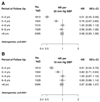Blood Pressure and Risk of Vascular Dementia: Evidence From a Primary Care Registry and a Cohort Study of Transient Ischemic Attack and Stroke
- PMID: 27165956
- PMCID: PMC5341765
- DOI: 10.1161/STROKEAHA.116.012658
Blood Pressure and Risk of Vascular Dementia: Evidence From a Primary Care Registry and a Cohort Study of Transient Ischemic Attack and Stroke
Abstract
Background and purpose: Vascular dementia is the second most common form of dementia but reliable evidence on age-specific associations between blood pressure (BP) and risk of vascular dementia is limited and some studies have reported negative associations at older ages.
Methods: In a cohort of 4.28 million individuals, free of known vascular disease and dementia and identified from linked electronic primary care health records in the United Kingdom (Clinical Practice Research Datalink), we related BP to time to physician-diagnosed vascular dementia. We further determined associations between BP and dementia in a prospective population-based cohort of incident transient ischemic attack and stroke (Oxford Vascular Study).
Results: For a median follow-up of 7.0 years, 11 114 initial presentations of vascular dementia were observed in the primary care cohort after exclusion of the first 4 years of follow-up. The association between usual systolic BP and risk of vascular dementia decreased with age (hazard ratio per 20 mm Hg higher systolic BP, 1.62; 95% confidence interval, 1.13-2.35 at 30-50 years; 1.26, 1.18-1.35 at 51-70 years; 0.97, 0.92-1.03 at 71-90 years; P trend=0.006). Usual systolic BP remained predictive of vascular dementia after accounting for effect mediation by stroke and transient ischemic attack. In the population-based cohort, prior systolic BP was predictive of 5-year risk of dementia with no evidence of negative association at older ages.
Conclusions: BP is positively associated with risk of vascular dementia, irrespective of preceding transient ischemic attack or stroke. Previous reports of inverse associations in old age could not be confirmed.
Keywords: blood pressure; dementia; epidemiology; hypertension; transient ischemic attack.
© 2016 American Heart Association, Inc.
Conflict of interest statement
We declare no competing interests.
Figures




References
-
- Gorelick PB, Scuteri A, Black SE, Decarli C, Greenberg SM, Iadecola C, Launer LJ, Laurent S, Lopez OL, Nyenhuis D, Petersen RC, et al. Vascular contributions to cognitive impairment and dementia: a statement for healthcare professionals from the american heart association/american stroke association. Stroke. 2011;42:2672–2713. - PMC - PubMed
-
- Pendlebury ST, Rothwell PM. Prevalence, incidence, and factors associated with pre-stroke and post-stroke dementia: a systematic review and meta-analysis. Lancet Neurol. 2009;8:1006–1018. - PubMed
-
- Ballard C, Neill D, O'Brien J, McKeith IG, Ince P, Perry R. Anxiety, depression and psychosis in vascular dementia: prevalence and associations. J Affect Disord. 2000;59:97–106. - PubMed
Publication types
MeSH terms
Grants and funding
LinkOut - more resources
Full Text Sources
Other Literature Sources
Medical

